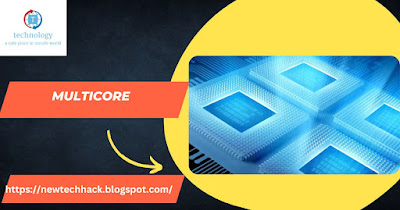Multicore
refers to a design approach in computer processors where multiple cores, or individual processing units, are integrated onto a single chip. Each core operates independently and can execute tasks concurrently, enabling parallel processing and improved performance.
Traditionally, processors were designed with a single core that handled all computational tasks. However, as the demand for higher performance and increased processing power grew, the limitations of single-core processors became evident. The frequency or clock speed of single-core processors reached a plateau due to power consumption and heat dissipation challenges.
To overcome these limitations, multicore processors were introduced. Here are some key aspects of multicore technology:
- Parallel Processing: Multicore processors allow for parallel processing, where different cores can execute tasks simultaneously. This parallelism enables faster and more efficient execution of multiple tasks, leading to improved overall performance.
- Increased Performance: Multicore processors can deliver higher performance compared to single-core processors, especially for tasks that can be divided into multiple threads or independent processes. Applications that are designed to take advantage of parallel processing can see significant speedups with multicore architectures.
- Multitasking and Multithreading: Multicore processors enhance multitasking capabilities by enabling the execution of multiple tasks concurrently. Each core can be assigned a different task, allowing for smoother multitasking experiences. Multithreading, which involves dividing a single task into smaller threads that can be executed simultaneously, also benefits from the parallelism provided by multicore processors.
- Power Efficiency: Multicore processors can achieve better power efficiency compared to single-core processors. By distributing the workload across multiple cores, each core can operate at a lower frequency or enter a low-power state when not actively processing, reducing overall power consumption.
- Scalability: Multicore technology offers scalability, allowing for the integration of more cores onto a single chip. Dual-core, quad-core, hexa-core, octa-core, and even higher core count processors are available, catering to a range of performance requirements.
- Challenges and Optimization: Developing software that fully harnesses the potential of multicore processors can be challenging. It requires designing applications to effectively distribute tasks across multiple cores and synchronize data access to avoid conflicts. Optimizing code for multicore architectures involves utilizing parallel algorithms, minimizing dependencies between tasks, and leveraging parallel programming frameworks and libraries.
Multicore processors have become ubiquitous in modern computing systems, from desktop computers and laptops to servers and mobile devices. They have enabled advancements in areas such as scientific simulations, data analysis, multimedia processing, virtualization, and gaming.
However, it's important to note that not all applications can fully leverage multicore processors. Some tasks are inherently sequential or dependent on single-threaded performance, and thus may not benefit significantly from multiple cores. The effectiveness of multicore technology depends on the workload and how well it can be parallelized.
In conclusion, multicore processors have revolutionized computer architecture by providing parallel processing capabilities and improving performance in a power-efficient manner. They have become a fundamental component of modern computing systems, enabling faster multitasking, enhanced scalability, and the potential for more efficient utilization of computational resources.






No comments:
Post a Comment